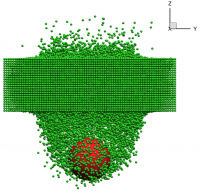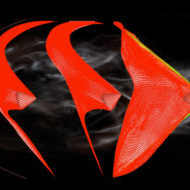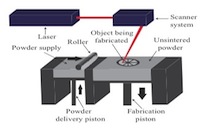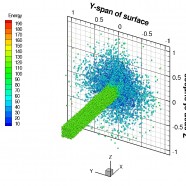Thermal Barrier Coatings
Research by: Peter Minor To protect against high temperatures, gas turbines use highly porous ceramic thermal barrier coatings (TBCs) which are susceptible to erosion and foreign object impact damage. Few numerical tools exist which are capable of both accurately capturing the specific failure mechanisms inherent to TBCs and iterating design parameters without the requirement for coupled experimental data. To overcome these limitations, I’m developing a discrete element model (DEM) to simulate the microstructure of a TBC using a large-scale assembly of bonded particles. The particles can be combined to create accurate representations of TBC geometry and porosity. The inclusion of collision-driven particle dynamics and bonds derived from displacement-dependent force functions endow the microstructure model with the ability to deform and reproduce damage in a highly physical manner. Typical TBC damage mechanisms such as compaction, fracture and spallation occur automatically, without having to tune the model based on experimental observation. Therefore, the first order performance of novel TBC designs and materials can be determined numerically, greatly decreasing the cost of development. To verify the utility and effectiveness of the proposed damage model framework, a nanoindentation materials test simulation was developed to serve as a test case. A good correlation was found between the predicted properties calculated by the model and those found through experimental nanoindentation tests. Furthermore, conforming to the benefits of DEM, the model was able to accurately recreate the same material damage characteristics observed in literature, such as the onset of inelastic deformation from fracture and creep. Watch the...
Read MoreElectromagnetically Sensitive Ballistic Fabric
Research by: Alejandro Queiruga High strength textiles are a fundamental component of armors in multiple applications, where they are coupled with metal and ceramic plates and various other systems. In this research, the effect of applying electromagnetic fields to a ballistic fabric undergoing impact is explored, wherein an external magnetic field induces deformation in an electrified sheet to influence the behavior of the projectile. The interaction between the applied electromagnetic fields and the resulting range of forces that can be applied onto the moving projectile is modeled by simplified analytical relations to inform the design space. A computational model used to simulate the dynamic system of the projectile and a layered ballistic fabric with coupled electromagnetic, mechanical, and contact physics. A single sheet of the ballistic fabric is modeled as a lattice of lumped masses interconnected by yarn segments. The electromagnetic properties of the fabric are modeled by solving an electrical network model on the lattice. A rigid-body projectile model is coupled to the fabric model that can handle arbitrary surface geometries. The interaction between layers of fabric sheets is incorporated through a nodally based contact model. The effect of altering the geometry of the projectile as well as the number of sheets used in the armor is explored through the model. Watch the...
Read MoreMultiphysical Modeling and Simulation of Selective Laser Sintering
Research by: Rishi Ganeriwala Additive manufacturing refers to a relatively recent group of manufacturing technologies whereby one can “3D print” parts, which has the potential to significantly reduce waste and alter the entire industry. Selective laser sintering/ melting (SLS/ SLM) is one type of additive manufacturing technology with the distinct advantage of being able to 3D print metals. In SLS/ SLM parts are built up layer-by-layer out of powder particles, which are selectively melted via a laser. However, in order to produce defect free parts of sufficient strength, the process parameters (laser power, scan speed, layer thickness, etc.) must be carefully optimized. Obviously, these process parameters will vary depending on material, part geometry, and desired final part characteristics. Thus, the aim of this research is to produce a multiphysical, computational model of SLS/ SLM so that the process parameters can be quickly optimized without the need for running numerous costly, and energy intensive experiments. Click on the following links for videos of the simulation. Videos: Deposition and subsequent laser heating of a layer of metal, powder particles using the discrete element method (DEM). Each individual particle is assumed to be spherical in shape and to have a homogenous temperature. Single pass of a laser beam over a pre-deposited layer of steel powder particles. In this simulation DEM particles are placed on top of the solid, underneath substrate, which is modeled via the finite difference method (FDM). Particles colored red indicate that they have melted, and side view of the same simulation. Notice how part of the underneath substrate layer is also melted (in addition to the particles). This is desirable to ensure proper bonding between layers during the SLS/ SLM...
Read MoreFlowing particulate media
Flowing particulate media are ubiquitous in a wide spectrum of applications that include transport systems, fluidized beds, manufacturing and materials processing technologies, energy conversion and propulsion technologies, sprays, jets, slurry flows, and biological flows.
Read MoreColliding and Flowing Particles
Flowing particulate media are ubiquitous in a wide spectrum of applications that include transport systems, fluidized beds, manufacturing and materials processing technologies, energy conversion and propulsion technologies, sprays, jets, slurry flows, and biological flows. The discrete nature of the media, along with their underlying coupled multi-physical interactions can lead to a variety of interesting phenomena, many of which are unique to such media. My research explores the utility of numerical simulations based on the discrete element method and collision driven particle dynamics methods for analyzing flowing particulate media. I have developed a FORTRAN based software library for discrete particle simulations, and used it to analyze the flow of an erosive stream of particles impacting a target surface, and the flow and deposition of particulate sprays. Currently, I am working on extending the discrete particle calculations to two-way coupled fluid-particle interaction problems. Watch the...
Read MoreAblation
Roll-to-roll manufacturing has the potential to be a high throughput and low cost technique for producing flexible electronics. Currently, however the inability to control the flow of the inks precisely prevents the creation of the sharp and small features needed to produce electronics. In my research, I am using the Discrete Element Method (DEM) to explore the whether laser ablation can be used to improve the properties of the printed features. A general DEM simulation environment has been written allowing for multiple element types each with distinct properties and interactions relations. To model ablation, particles that reach their evaporation temperature loss mass in accordance with heat input and their heat of vaporization which results in a decrease in radius of the element. If the elements exhibit attract behaviour this can have the result of drawing in surrounding elements. With this simulation framework, we are examining if with different shaped heat sources, intensities and ligand properties it is possible to create different geometries of self assembled nano-particles. Watch the video…...
Read More






